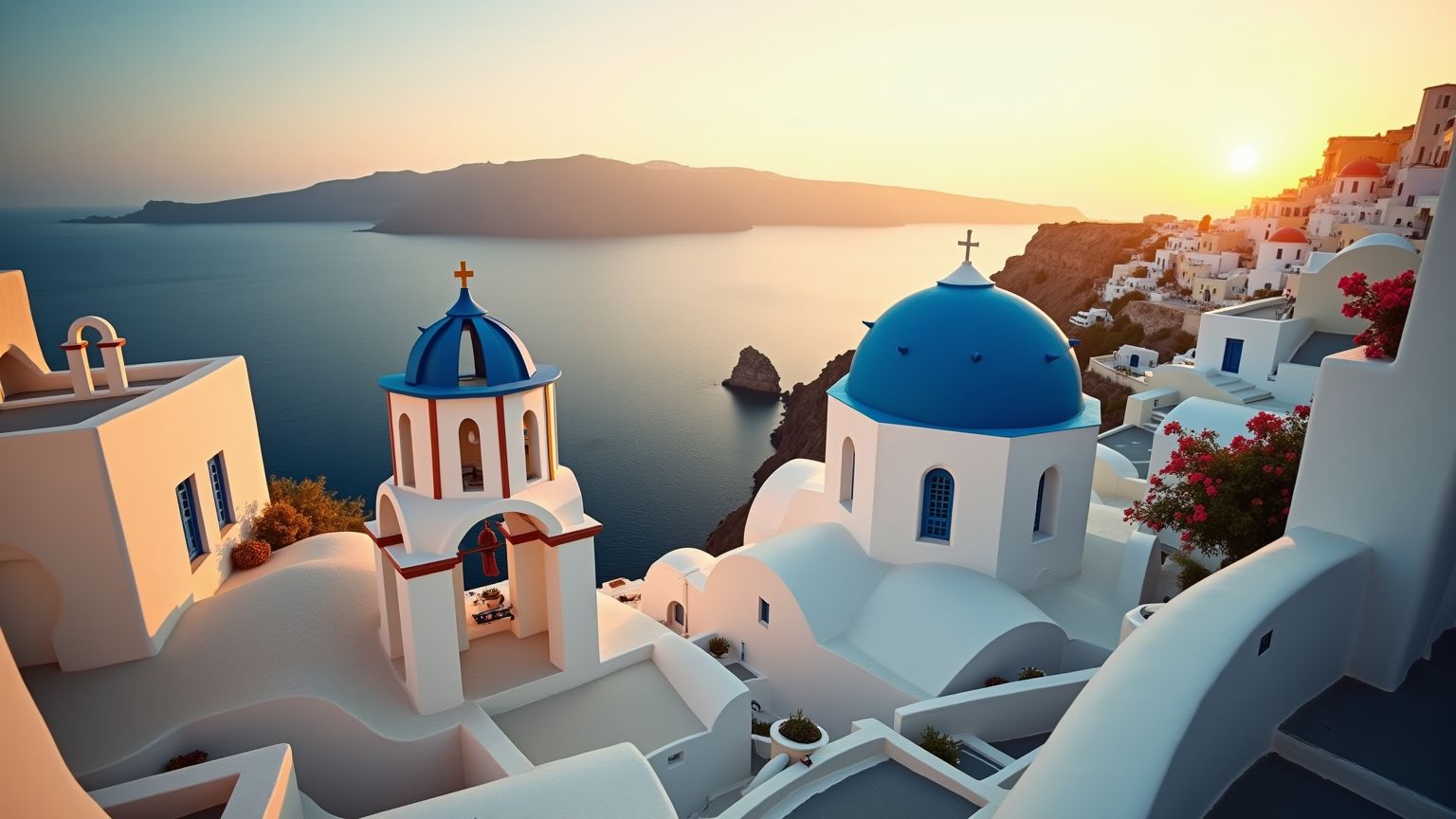The Enchanting Story Behind Greece Blue and White: A Complete Guide to Its History, Symbolism and Best Places to Experience It
After 15 years of showing folks around Greece, I've heard one question more than any other when we turn a corner to discover those hillside villages with their striking greece blue and white buildings: "So... why blue?"
Fair enough. It's not every day you see a color so deeply woven into a nation's identity – appearing on everything from the national flag to those picture-perfect domed churches.
The greece blue and white palette isn't just pretty – it's a living story, a piece of history you can see and touch. Through this guide, I'll unpack the rich tale behind Greece's famous blue, from ancient times to today's Instagram hotspots. Whether you're a first-timer or returning for another Greek adventure, knowing the "why" behind those blues makes every view more meaningful.
The Historical Roots of Greece's Blue Tradition

Ancient Beginnings: Blue in Greek Antiquity
Long before tourists flocked to snap photos of Santorini, the greece blue and white aesthetic had deep roots. Archaeological finds show that ancient Greeks valued blue, though it wasn't necessarily their showstopper color.
They called it "kyanos" (which gave us "cyan" in English). This rich blue pigment came from copper minerals and was seriously precious stuff. Blue was such a pain to produce that it was mostly saved for important artwork and wealthy homes. Check out the blue-painted murals at Knossos in Crete (dating back to 2000 BCE) and you'll see how early the color mattered here.
Oddly enough, Homer barely mentions blue in his epics, instead describing the sea as "wine-dark" – leading some scholars to wonder if ancient Greeks even saw blue the way we do today. Talk about a head-scratcher!
The Byzantine Influence
When Christianity swept through Greece during the Byzantine era (330-1453 CE), the greece blue and white connection deepened. Deep azure blues became associated with divinity, with the Virgin Mary often depicted in flowing blue robes. This spiritual link elevated blue from "just another color" to something profoundly meaningful.
- Walk into any Byzantine church today
- Notice how blues dominate the mosaics
- Feel the spiritual weight the color carried
- Understand how this influenced centuries of Greek aesthetics
The Ottoman Period and the Birth of Modern Greek Identity
Under nearly four centuries of Ottoman rule, the greece blue and white palette took on new significance. Greek identity became tightly entwined with Christianity as people sought to maintain their cultural distinction. Those blues adorning churches became subtle symbols of resistance and identity.
When Greece finally won independence in 1830, blue was the natural choice for the national flag – making official what everyone already felt: blue was Greece's color. That flag design, with its greece blue and white cross pattern (later modified to include stripes), directly connected blue with Greek freedom and nationhood.
The Practical Evolution of Greece's Blue and White Aesthetic
The Whitewashing Tradition: Necessity Becomes Beauty
That postcard-perfect greece blue and white look actually started from practicality, not aesthetics. In the 1930s and 40s, the Greek government made whitewashing buildings mandatory on many islands. This wasn't just for looks – it served several crucial purposes:
- Disease fighter - Lime whitewash disinfected surfaces, crucial after a devastating typhus epidemic in 1938
- Natural cooling - White surfaces bounce back sunlight, keeping interiors bearable during scorching summers
- Fire protection - The lime coating provided a basic defense against flames in tight village layouts
- Cheap and available - Limestone was everywhere and cost next to nothing
As for that gorgeous greece blue and white contrast we now associate with Greek islands? The blue came from copper sulfate mixed with limestone – cheap, readily available, and bonus: it repelled insects because of the copper. Island folks were just using what they had at hand, not trying to create a global brand!
From Necessity to National Brand
What began as simple practicality morphed into full-blown cultural identity. By the mid-20th century, as tourism picked up in post-war Greece, the government spotted the appeal of this distinctive look. In 1967, the military government officially mandated the greece blue and white color scheme for buildings in many island communities.
Tourism campaigns in the 70s and 80s plastered those dreamy blue-domed churches against white buildings across travel magazines worldwide. A practical local solution became Greece's most powerful visual calling card—perhaps the perfect example of functional architecture accidentally creating an iconic look.
The Many Symbolisms of Greek Blue
Blue in Greek Folk Beliefs: Beyond Aesthetics
While visitors might just see "pretty buildings," that vibrant greece blue and white has deeper meaning for locals. The cobalt blue (locally still called "kyanos") painted around doors and windows isn't just decorative – it's protective.
In Greek folk tradition, this particular shade of blue wards off the "evil eye" (matiasma) – a curse caused by jealousy. This belief remains surprisingly strong in modern Greece, which is why you'll find those little blue eye amulets (mati) in every souvenir shop from Athens to Zakynthos.
I've watched elderly villagers meticulously refresh the greece blue and white on their homes each spring – not just for curb appeal, but as a continuation of this protective ritual that's endured for generations.
Blue in Greek Orthodox Tradition
The greece blue and white palette runs deep in Greek Orthodox practice. Those blue domes crowning churches symbolize heaven and divine truth. The color represents the transcendent realm and particularly the Virgin Mary, whose icons typically feature a blue mantle.
This spiritual significance explains why the most photographed churches – from Santorini's famed three blue domes to countless island chapels – feature this heavenly hue. It's beauty with profound meaning.
Blue in Contemporary Greek Identity
Today, greek blue and white carries multiple meanings simultaneously:
- National pride: Along with white, blue represents Greece officially in the flag
- Maritime heritage: For a nation with 9,000+ miles of coastline, blue naturally symbolizes the sea-faring tradition
- Welcome sign: The blue-white aesthetic instantly signals "Greece" to visitors worldwide
- Natural reflection: Many locals will tell you their blue simply mirrors the perfect azure of the Aegean and Mediterranean sky
Where to Best Experience Greece's Iconic Blue
The Cycladic Islands: Blue in Its Most Famous Form
For the ultimate greece blue and white experience, nothing beats the Cyclades:
Santorini (Thira): The undisputed champion of greece blue and white aesthetics. The caldera villages of Oia and Fira feature those world-famous blue domes atop whitewashed churches. For the money shot, visit the Three Blue Domes of Oia – but get there early, as photographers stack three-deep by sunset. Insider tip: try late April or October when the crowds thin but weather stays lovely.
Mykonos: Beyond its famous windmills, Mykonos Town (Chora) is a maze of narrow streets lined with brilliant greece blue and white buildings. Unlike Santorini's domes, Mykonos embraces blue in its doors, shutters, and furniture. The church of Panagia Paraportiani showcases this interplay perfectly.
Paros and Antiparos: These sister islands offer a more authentic, less trampled version of the Cycladic greece blue and white aesthetic. Naoussa's fishing village on Paros features charming blue-trimmed buildings lining its tiny harbor, while inland Lefkes preserves traditional architecture without the tourist hordes.
Milos: Often overlooked but spectacular for greece blue and white photography, especially in the fishing village of Klima. Here, boathouses (syrmata) feature colorful doors – many in varying shades of blue – creating absolute visual magic.
Beyond the Cyclades: Different Blues Across Greece
The greece blue and white combination appears differently throughout the country:
Thessaloniki: Greece's second city showcases blue in Byzantine churches, particularly the stunning mosaics of the 5th-century Church of Hosios David.
Symi: This Dodecanese island features neoclassical mansions with a distinctive soft blue – a gentler take on the classic greece blue and white palette.
Joannina: In northern Greece, blue appears in the detailed ceramics made in this lakeside city – the color showing up in delicate patterns rather than bold architectural statements.
Meteora: While famous for monasteries perched on dramatic rock formations, inside you'll discover beautiful blue-gray Byzantine frescoes – a subtler expression of traditional greek blue and white artistry.
Athens: Even in the bustling capital, pockets of traditional greece blue and white exist, especially in the historic Plaka district where some preserved houses maintain blue shutters amid the urban landscape.
Seasonal Considerations for Viewing Greek Blue
The greece blue and white aesthetic shifts with seasons and light:
Spring (April-May): Perhaps the most magical time to experience greek blue and white combinations, as the buildings pop against hillsides covered in wildflowers.
Summer (June-August): Intense Mediterranean sun creates high contrast between greece blue and white elements, but brings the biggest crowds and scorching temps.
September-October: My personal favorite for appreciating architectural details – softer autumn light creates subtle shadows while tourist numbers plummet.
Golden hour: Photographers take note: the hour before sunset transforms greece blue and white buildings, giving them a luminous quality as surfaces reflect warm late-day light.
Preserving Tradition While Looking Forward
Challenges to Greece's Blue Tradition
While the greece blue and white aesthetic seems timeless, it faces modern challenges:
Traditional lime whitewash demands yearly maintenance – a time-consuming process some residents find increasingly impractical. Modern paints last longer but often lack that luminous quality that makes traditional greece blue and white so photogenic.
Tourism creates a complex situation: the popularity of the iconic look brings essential income, but also pressures some communities to maintain an aesthetic that originally emerged from necessity, not visitor appeal.
Climate regulations sometimes conflict with tradition, as energy-efficiency requirements and safety concerns must balance with preserving the authentic greece blue and white heritage.
Contemporary Interpretations of Greek Blue
Greek designers are finding fresh ways to incorporate the national blue:
Modern boutique hotels throughout the islands reinterpret traditional greece blue and white with contemporary furnishings and architectural details, maintaining cultural continuity while embracing modern comfort.
Greek fashion designers like Mary Katrantzou weave traditional blue into contemporary clothing lines, creating wearable connections to Greek heritage without feeling costume-like.
Contemporary ceramic artists continue working with traditional greece blue and white glazes while creating pieces with modern sensibilities – heritage meets innovation.
Experiencing Greek Blue Beyond Architecture
To truly appreciate Greece's blue tradition, look beyond the famous buildings:
Blue in Greek Dining: Notice the blue-and-white patterns on traditional ceramics and tablecloths in authentic tavernas. Even the humble paper placemats in seaside restaurants often feature greece blue and white designs.
Festivals and Celebrations: During religious festivals, particularly those honoring the Virgin Mary, greece blue and white decorations adorn streets and churches – the colors taking on celebratory significance.
Natural Blues: Greece's most spectacular blues aren't man-made at all. The Blue Caves of Zakynthos, the otherworldly waters of Navagio Beach, and the deep blue volcanic crater lake on Nisyros remind visitors that Greece's iconic blue ultimately draws inspiration from the extraordinary natural environment.
Bringing Greece's Blue Home
Many visitors want to incorporate elements of greece blue and white into their own homes after experiencing its beauty firsthand:
- Traditional evil eye amulets (mati) make meaningful souvenirs that capture that distinctive blue
- Hand-painted ceramics from Athens, Rhodes or Sifnos bring functional pieces of greece blue and white into daily life
- Textiles with meandros patterns (the Greek key design) in blue and white offer subtle ways to reference Greek heritage
Final Thoughts: The Enduring Appeal of Greek Blue
After guiding thousands of visitors through Greece, I've noticed how our greece blue and white creates an almost emotional connection with visitors. There's something about this particular shade – whether crowning a church on Santorini or decorating a fishing boat in some tiny harbor – that captures imaginations and becomes emblematic of the entire Greek experience.
Perhaps it's because greece blue and white sits at the intersection of natural beauty, spiritual tradition, practical ingenuity, and cultural identity. It's a color valued since antiquity yet feels eternally fresh and inviting.
The blue of Greece isn't just pretty – it's living heritage that continues evolving while keeping one foot firmly planted in ancient tradition. In our chaotic world, there's something deeply reassuring about walking through a Greek village and seeing the same blue that has watched over countless generations of island life.
Whether planning your first Greek adventure or returning to deepen your connection with this remarkable country, I hope this deeper understanding of our distinctive greece blue and white adds richness to what you see. Beyond those Instagram-worthy views lies a complex story of adapting to environment, expressing identity, and creating beauty from necessity – quintessentially Greek qualities that our beloved blue continues to embody.








